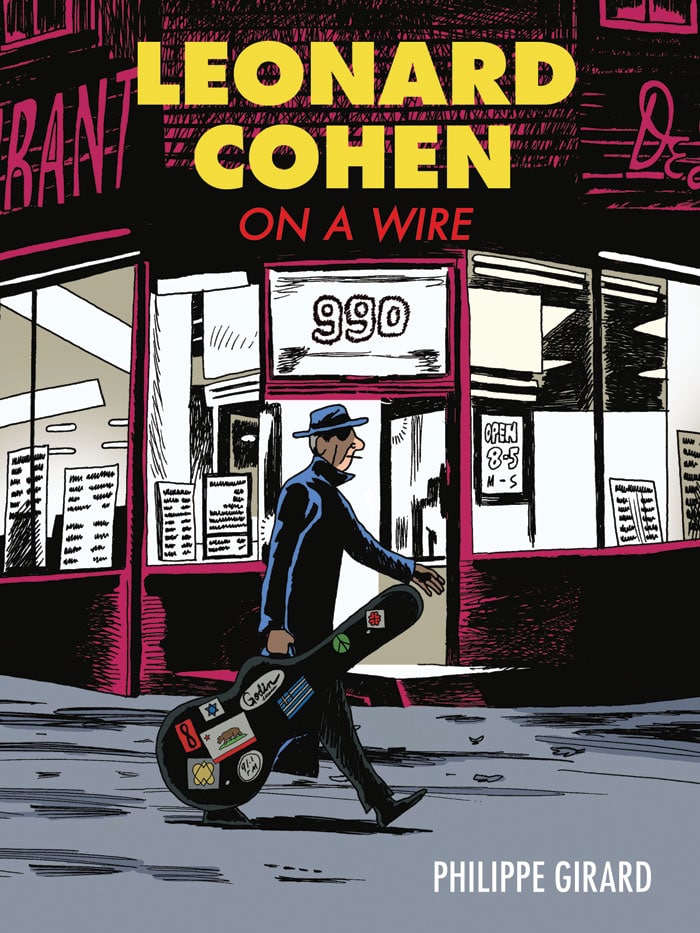
Leonard Cohen didn’t have a typical journey for a rock star. Growing up in an Orthodox Jewish home in Canada, he officially started his music career when he was 33 years old, only after working as a poet and novelist and living on the Greek island of Hydra for a number of years.
Cohen’s dynamic life – as well as the struggles the musician faced – are what intrigued illustrator Philippe Girard and convinced him to put out a new graphic novel about Cohen called, “Leonard Cohen: On a Wire.”
“For someone with such a big aura, he was really relatable. His resilience is what attracted me the most.”— Philippe Gerard
“He was such a man of the people even though he was a big star,” Girard said. “For someone with such a big aura, he was really relatable. His resilience is what attracted me the most.”
The graphic novel starts in 2016, when Cohen died. On the night of his death, he falls to the floor of his Los Angeles home, and contemplates how he is “going to die here, all alone, like a dog.” Outside his window is a bird on a wire, a reference to his 1969 tune in which he sang, “Like a bird on the wire, like a drunk in a midnight choir, I have tried, in my way to be free.”

The book flashes back to a traumatic scene from Cohen’s childhood in which his dog crawled under the porch to die alone and Cohen discovered his body. It then takes the reader through Cohen’s first career as a writer, and eventually to when he became a professional musician. Along the way, he meets contemporaries like Lou Reed and Nico and has flings with Janis Joplin and Joni Mitchell. At one point, Phil Spector holds a gun to his head.
Although Cohen was a star, he had his share of setbacks. “Hallelujah” didn’t become a hit until Jeff Buckley recorded it, and in the early 2000s, it came to light that his longtime manager had embezzled more than $5 million from him. Still, it didn’t stop him from touring and writing music; he released his last album two weeks before he died.
“When he passed away, I thought there would be a book that would come out very quickly and I would be disappointed in it,” said Girard. “But the book wasn’t coming out. I thought maybe I should do it the right way, up to my standards.”
Girard was a longtime fan of Cohen’s. When he was a teenager, he was visiting his cousin in Montreal, a place where many famous people lived. He imagined that the famous people there wore disguises so they wouldn’t get noticed on the street. The two were taking a walk when Girard’s cousin pointed out that they just passed Leonard Cohen, who was plainly dressed.
“I said ‘He is nothing special,’” said Girard. “Then, I went and bought a record of his.”
The illustrator spent six months researching Cohen’s life. There was so much information that he said he “had to make a choice and decide what to tell and what to leave. Cohen used to say he lived 1,000 lives, and you realize this is true.”
Girard started his graphic novel by drawing a Star of David on a piece of paper. Cohen’s death was in the middle of the star, and each tip of the star would represent one woman, song and object for each decade of the musician’s life.
Though Girard isn’t Jewish, when he was working on the book, he took a trip to Kraków and visited a concentration camp.
“Leonard Cohen was with me the whole time,” he said. “When you read about him, you see that [the Holocaust] was an influence, but also a big source of stress on his imagination.”
Though Cohen practiced Zen Buddhism, he was a proud Jew throughout his life and performed for the Israeli troops during the 1973 Arab-Israeli war. His songs like “Hallelujah” and “You Want It Darker” have Jewish themes; in the latter, he sang, “Hineni, hineni; I’m ready, my Lord.” And “Who By Fire” is based on the “Unetanneh Tokef” prayer.
Cohen’s raw honesty in his songs, as well as his challenges – which became very public – are what made him so human, and why Girard thought he was a fascinating subject to highlight.
“He was trying to reach out to people,” Girard said. “It’s something I really respect. There is a great humanity about him. I hope people will get interested and read his books and listen to his music.”





















 More news and opinions than at a Shabbat dinner, right in your inbox.
More news and opinions than at a Shabbat dinner, right in your inbox.